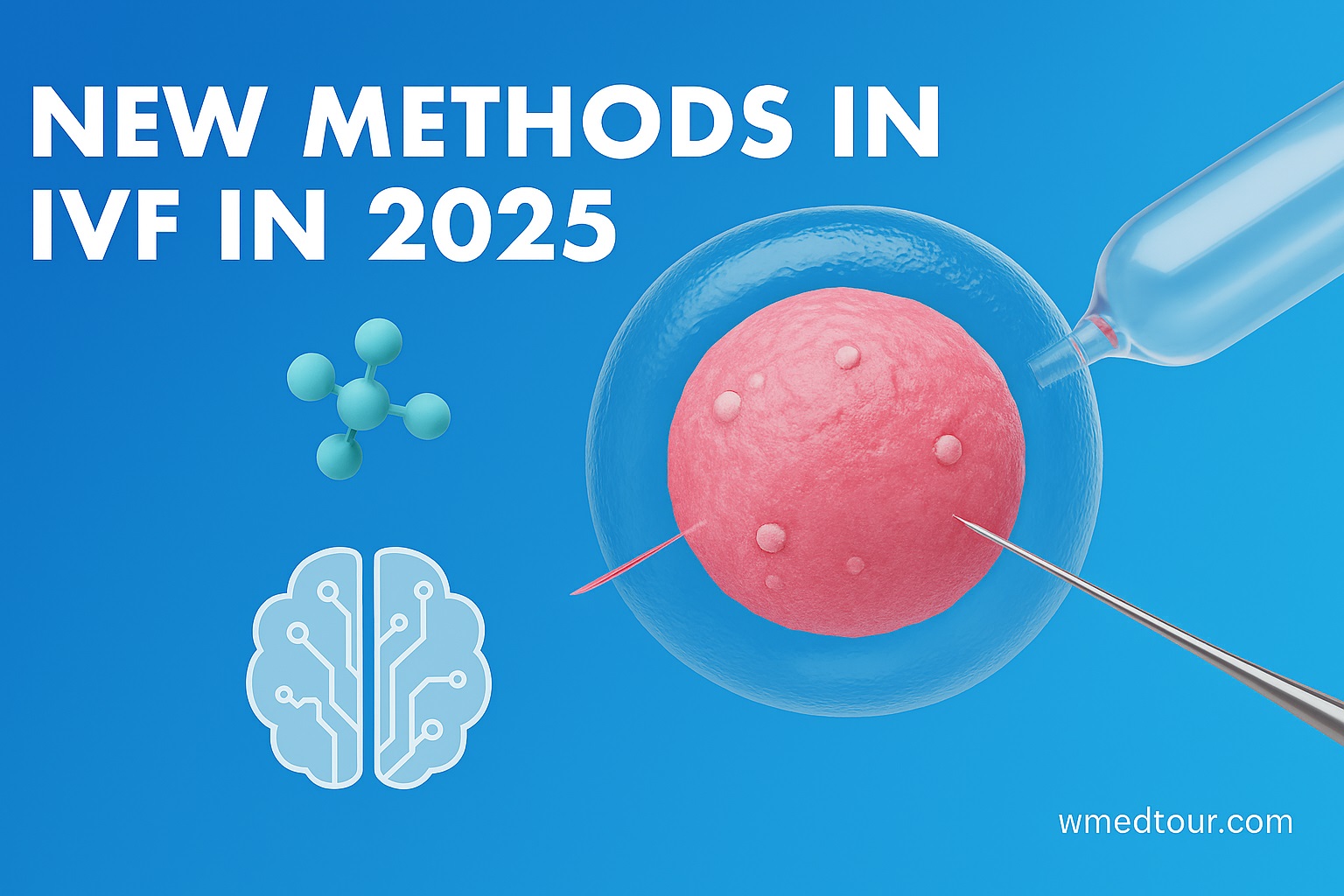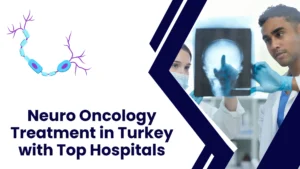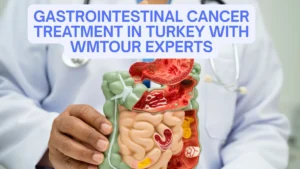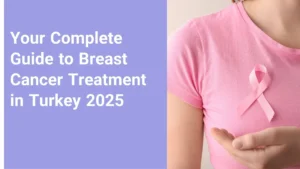New methods in IVF in 2025: Precision Fertility with AI and niPGT – The Future of Conception
The journey through infertility is often marked by hope, uncertainty, and the relentless search for better outcomes. Fortunately, the field of In Vitro Fertilization (IVF) is not static; it constantly evolves. As we look ahead, the year 2025 marks a pivotal moment, introducing truly transformative technologies. This article explores the core of these advancements: the convergence of Artificial Intelligence (AI) and non-invasive Preimplantation Genetic Testing (niPGT), offering unprecedented accuracy and ease. Together, these elements define the New methods in IVF in 2025: Precision Fertility with AI and niPGT, setting a new global standard for fertility success.
Executive Summary: Key Takeaways
The new era of fertility treatment is defined by precision and non-invasiveness. Here are the critical takeaways for individuals considering modern IVF:
- AI-Powered Embryo Selection: AI algorithms now analyze time-lapse imaging to identify the most viable embryos with greater accuracy than human embryologists, substantially boosting implantation rates. This technological leap is a major component of the New methods in IVF in 2025: Precision Fertility with AI and niPGT.
- Non-Invasive PGT (niPGT): This revolutionary technique analyzes DNA fragments released by the embryo into the culture medium, removing the need for an intrusive biopsy. This reduces stress on the embryo and streamlines the process.
- Global Accessibility: Many leading international clinics are rapidly adopting these technologies, offering patients worldwide access to these cutting-edge procedures, often paired with cost-effective medical tourism packages. Explore global IVF costs.
- Improved Patient Experience: The reduced invasiveness of niPGT and the increased certainty provided by AI contribute to a less stressful, more efficient, and ultimately more successful patient journey.
The Role of AI in Embryo Selection: A New Era of Predictive Power
Historically, embryologists assessed embryo quality primarily based on morphological criteria—observing cell size, shape, and division speed under a microscope. While effective, this method was inherently subjective and limited by what the human eye could process. Now, the New methods in IVF in 2025: Precision Fertility with AI and niPGT introduce a powerful collaborator: Artificial Intelligence.
How AI Transforms the Lab
AI utilizes sophisticated machine learning algorithms trained on thousands of successful IVF cycles. It analyzes time-lapse video data, monitoring subtle, critical kinetic markers that correlate with implantation potential. For instance, the exact timing of cell division, the degree of cytoplasmic fragmentation, and even the appearance of pronuclei are all analyzed far beyond the capability of manual grading. Therefore, this enhanced analytical power allows for the objective selection of the embryo with the highest chance of resulting in a live birth, thereby making treatment decisions more transparent and successful. Moreover, this shift is profoundly reshaping global clinical practice. Learn more about gynecological surgery.
Pros and Cons of AI in Embryo Selection
Pros (Advantages)
- Increased Implantation Rates: AI’s precision significantly improves the selection accuracy, which translates to fewer failed transfers.
- Reduced Time to Pregnancy: By selecting the best embryo on the first or second attempt, patients can achieve pregnancy faster.
- Elimination of Subjectivity: Standardizes the embryo grading process across different clinics and embryologists.
- Reduced Miscarriage Risk: Better selection often correlates with the transfer of genetically healthier embryos.
Cons (Challenges)
- High Initial Cost: Implementing AI systems and time-lapse technology requires a significant investment for clinics.
- Data Dependency: The algorithms are only as good as the data they are trained on, necessitating large, high-quality datasets.
- Regulatory Hurdles: As a relatively new technology, regulatory approval and clinical validation continue to evolve in some regions.
- Need for Specialized Staff: Clinics need technicians trained in managing and interpreting the AI output, not just the raw images.
niPGT: Non-Invasive Genetic Testing – Safety and Simplicity
Preimplantation Genetic Testing (PGT) screens embryos for chromosomal abnormalities (PGT-A) or specific genetic diseases (PGT-M) before implantation. While crucial for improving IVF outcomes, traditional PGT requires an embryologist to perform a biopsy—a delicate procedure that involves removing several cells from the trophectoderm (the part that becomes the placenta). Non-invasive PGT (niPGT) eliminates this step entirely, embodying the fundamental shift driving the New methods in IVF in 2025: Precision Fertility with AI and niPGT.
How niPGT Works
The mechanism behind niPGT is fascinatingly simple: embryos naturally release cell-free DNA (cfDNA) into the surrounding culture medium as they grow. Instead of biopsying the embryo itself, embryologists now collect and analyze this spent medium. Subsequent analysis of the cfDNA provides a comprehensive genetic assessment, essentially offering the benefits of PGT-A without the risk of physical intervention. Consequently, this innovation is paving the way for wider adoption of genetic screening. Check out different IVF treatments.
Pros and Cons of niPGT
Pros (Advantages)
- Zero Biopsy Risk: Eliminates the minimal, but present, risk of damaging the embryo through invasive cell removal.
- Simplified Lab Workflow: Reduces the specialized labor and time required for the biopsy procedure.
- Potential for Better Outcomes: Some studies suggest niPGT may lead to better live birth rates by reducing potential physical stress on the developing embryo.
- Applicable to More Embryos: Allows genetic screening even for embryos that are not suitable for a physical biopsy.
Cons (Challenges)
- Maternal Contamination: The sample can sometimes be contaminated with DNA from the patient’s own cells, leading to unclear results.
- Validation Ongoing: While promising, large-scale clinical trials are still solidifying its equivalence to traditional PGT-A across all patient groups. Read more on niPGT validation.
- Cost: Currently, the cost of the niPGT kit and analysis can sometimes be higher than the standard PGT biopsy fee.
- Mosaicism Interpretation: Interpreting results related to embryonic mosaicism remains a complex challenge, similar to traditional PGT.
Who is This For? Targeting the Right Patients
The integration of AI and niPGT into the clinical workflow is beneficial for nearly all IVF patients, but certain demographics stand to gain the most from the New methods in IVF in 2025: Precision Fertility with AI and niPGT:
- Patients with Advanced Maternal Age: Women over 35 face a higher risk of aneuploidy (chromosomal abnormalities). AI enhances the visual selection, and niPGT provides safer genetic verification. Consider PGT applications.
- Individuals with Recurrent Implantation Failure (RIF): For patients who have had multiple failed IVF cycles, the objective, high-precision screening offered by AI and niPGT is crucial for identifying the highest quality embryo and breaking the cycle of failure.
- Patients Requiring PGT-M/A: Anyone needing genetic testing—for inherited diseases or chromosomal issues—can benefit from the safer, non-invasive nature of niPGT.
- Those Seeking Cost-Effectiveness: Although the initial cost may be slightly higher, the vastly increased success rate per transfer ultimately reduces the number of required cycles, leading to significant savings in total treatment cost and emotional burden. Understand the global cost implications.
Comparison Table: Traditional IVF vs. Precision IVF (AI + niPGT)
To fully appreciate the scope of the New methods in IVF in 2025: Precision Fertility with AI and niPGT, comparing the modern approach with traditional IVF methods is essential. This table highlights the significant advantages of the 2025 protocols.
| Feature | Traditional IVF (2020 Protocol) | Precision IVF (2025 Protocol: AI + niPGT) |
|---|---|---|
| Embryo Selection Method | Manual, subjective morphological grading by embryologist. | AI-powered analysis of time-lapse kinetics and morphology. |
| Genetic Testing (PGT) | Invasive Trophectoderm Biopsy. | niPGT: Non-invasive cfDNA analysis from culture medium. |
| Risk of Embryo Damage | Minimal but present risk from biopsy procedure. | Effectively zero risk from the testing procedure itself. |
| Success Rate Per Cycle (Approx.) | 30%-45% (varies greatly by age/clinic). | Up to 55%-70% (due to enhanced selection accuracy). |
| Overall IVF Efficiency | Often requires multiple cycles to find a viable embryo. | Faster, more efficient, reducing the overall time to successful pregnancy. |
Hypothetical Patient Journey: Embracing Precision Fertility
Consider the case of Maria and Alex, a couple in their late 30s who had endured two unsuccessful, traditional IVF cycles over three years. Their previous cycles resulted in several embryos, but only one transferable embryo each time, both of which failed to implant. The emotional and financial toll was significant.
“After two failed cycles, Maria and Alex were considering stopping treatment. Their new clinic introduced the New methods in IVF in 2025: Precision Fertility with AI and niPGT as their last, best option.”
The Precision Protocol:
- AI Monitoring: The clinic utilized a time-lapse incubator integrated with an AI scoring system. From the 12 resulting blastocysts, the AI system scored four as “Tier 1: High Implantation Potential,” significantly narrowing the field based on kinetic data.
- niPGT Screening: The culture medium from all 12 embryos was collected. niPGT results confirmed that three of the four AI-selected embryos were euploid (chromosomally normal). This confirmed the synergy between AI’s kinetic prediction and niPGT’s genetic verification. Source: Journal of Human Reproduction.
- Successful Transfer: Maria received one of the top-ranked, niPGT-verified embryos. Because of the dual-layer precision, the couple felt profoundly more confident in this transfer. Nine days later, Maria had a positive pregnancy test.
This case demonstrates how the New methods in IVF in 2025: Precision Fertility with AI and niPGT transform despair into success by removing ambiguity and maximizing the potential of every single embryo. Find solutions for fertility problems abroad.
Beyond AI and niPGT: Other 2025 Breakthroughs
While AI and niPGT dominate the conversation, the comprehensive package of New methods in IVF in 2025: Precision Fertility with AI and niPGT includes several other crucial breakthroughs that further refine the process:
Improved Ovarian Stimulation and Culture Media
- Gentler Protocols: Tailored micro-dose stimulation protocols, guided by sophisticated pharmacogenomic testing, minimize side effects and improve egg quality, especially for patients with Polycystic Ovary Syndrome (PCOS) or Diminished Ovarian Reserve (DOR).
- Biomimetic Culture Systems: New culture media formulations more closely mimic the natural environment of the fallopian tube and uterus, providing optimal nutrition and environment for embryonic growth. See advancements in culture media.
Mitochondrial Donation Techniques
For patients facing severe infertility due to mitochondrial defects, techniques like Mitochondrial Replacement Therapy (MRT) are becoming more widely available in controlled international settings. This method replaces faulty mitochondria in the egg cell, preventing severe genetic diseases from being passed on and improving the egg’s energy supply, which is vital for early embryo development. Review other modern fertility methods.
Endometrial Receptivity Testing (ERA 3.0)
Advanced ERA testing, now often integrated with AI, precisely identifies the optimal window of implantation. This ensures that the perfectly selected embryo is transferred at the exact moment the uterus is most receptive, significantly increasing the odds of success. Understanding this synchronization is key to optimizing the New methods in IVF in 2025: Precision Fertility with AI and niPGT protocol. Detailed ICSI treatment guide.
Global Accessibility and Medical Tourism
One of the most exciting implications of the New methods in IVF in 2025: Precision Fertility with AI and niPGT is their increasing availability in global medical tourism destinations. Reputable clinics in countries known for advanced medical infrastructure often adopt these cutting-edge technologies rapidly. This gives patients access to the latest methods without the typical lengthy waiting lists or prohibitively high costs found in some Western countries.
For example, centers in Turkey, South Korea, and other international hubs are leveraging these technologies to deliver world-class success rates at a fraction of the price. The global hub portal simplifies this access, providing detailed information on accredited centers and transparent pricing for AI and niPGT-enhanced IVF cycles. Start your medical tourism research here.
“Choosing a clinic that has fully implemented the New methods in IVF in 2025: Precision Fertility with AI and niPGT is an investment in certainty and success. The combination is fundamentally shifting the IVF success curve upward for a global audience.”
Furthermore, prospective parents can explore related services such as gender selection risks, or investigate specialized fertility procedures like ICSI treatment costs. Information on IUI is also available. Tubal ligation reversal options and other tubal surgeries can be crucial preliminary steps. Pelvic floor treatments may also indirectly support reproductive health. Review the egg donation process for further options. Discover detailed IVF procedures.
Frequently Asked Questions (FAQ)
We compiled the most important questions about the New methods in IVF in 2025: Precision Fertility with AI and niPGT to help you make informed decisions.
1. What is the fundamental advantage of using AI in IVF?
Answer: The main advantage lies in objectivity and scale. AI objectively analyzes subtle, dynamic changes in embryonic development over time that are invisible to the human eye. This leads to a more accurate prediction of implantation potential, maximizing the chance of success in a single transfer.
2. Is niPGT as reliable as traditional PGT-A?
Answer: Current clinical data strongly suggests niPGT offers comparable diagnostic accuracy to traditional PGT-A. It is becoming the preferred method because it avoids the physical risks associated with embryo biopsy, offering a safer way to perform genetic screening. Nature Medicine study on niPGT.
3. Does AI replace the embryologist?
Answer: Absolutely not. AI is a powerful tool that assists and enhances the embryologist’s decision-making. The embryologist remains essential for sample handling, culture management, clinical interpretation, and performing the eventual embryo transfer. AI acts as an advanced, objective screening layer.
4. What is the approximate cost difference for an AI/niPGT cycle versus a traditional IVF cycle?
Answer: Generally, the AI monitoring and niPGT analysis add a premium to the base IVF package. However, because these technologies dramatically increase the success rate per transfer, the total cost of achieving a live birth often becomes lower than the cost of multiple failed traditional cycles. Compare costs in various countries.
5. Can niPGT screen for specific genetic diseases (PGT-M)?
Answer: Yes, niPGT primarily focuses on PGT-A (chromosomal screening) but is increasingly being adapted for PGT-M (single gene disorders). The challenge is ensuring sufficient cfDNA concentration for the detailed analysis required for PGT-M, but research is rapidly progressing.
6. Are these New methods in IVF in 2025: Precision Fertility with AI and niPGT suitable for all patients?
Answer: They are suitable for most patients, particularly those with advanced maternal age, a history of miscarriage, or previous implantation failure. However, a full medical consultation is always necessary to determine the best protocol based on individual health history.
7. How long does the niPGT testing take?
Answer: After the culture medium is collected (usually on Day 5 or 6 of development), the analysis typically takes 7 to 10 days, similar to the timeline for traditional PGT-A analysis, after which the embryo transfer can be scheduled.
8. Is it true that AI can predict the gender of the embryo?
Answer: While AI can identify chromosomal gender based on genetic markers (as part of PGT-A screening), its primary function is assessing embryo viability. AI is generally not used for gender prediction unless integrated with a PGT platform, and gender selection is performed for medical or legal reasons. Read about the ethics.
9. Does using AI and niPGT affect the embryo freezing process?
Answer: No. The niPGT sample is taken from the culture medium before freezing, and the AI analysis is completed during the culture period. The best-selected embryos are cryopreserved using standard, highly validated vitrification protocols, ensuring their safety.
10. Are there any long-term follow-up studies on children born from AI-selected embryos?
Answer: The underlying techniques (PGT and time-lapse imaging) have years of safety data. Because AI is simply an enhanced scoring system for selection, long-term safety data is highly favorable, with no known increased risks compared to children born from manually selected IVF embryos. WHO data on infertility treatments.
11. Where can I find reputable clinics offering New methods in IVF in 2025: Precision Fertility with AI and niPGT?
Answer: We recommend looking at accredited centers in established medical tourism destinations known for advanced fertility services. These centers invest heavily in the latest technology to attract international patients. Our platform offers verified lists and transparent pricing from these global clinics. Book a fertility check-up.
12. What other advanced IVF techniques should I research alongside niPGT?
Answer: You should also research time-lapse imaging (which powers the AI), mitochondrial replacement therapy (for specific cases), and advanced endometrial preparation techniques to maximize your success when combining them with the New methods in IVF in 2025: Precision Fertility with AI and niPGT. Learn about ICSI.
13. Does the use of AI/niPGT increase the likelihood of twins or multiples?
Answer: No, in fact, the opposite is true. Because AI and niPGT dramatically increase the confidence in selecting a single, highly viable embryo, these technologies strongly support the goal of single embryo transfer (SET), which is the safest path to pregnancy, thereby reducing the risk of multiples. CDC data on IVF and SET.
14. Can AI help personalize ovarian stimulation?
Answer: Yes. Beyond embryo selection, AI is increasingly used to analyze a patient’s hormone levels, ovarian reserve markers, and previous cycle data to predict optimal drug dosages and timing for ovarian stimulation, resulting in a better yield of high-quality eggs. Find a Women’s Health Checkup abroad.
Ready for the Future of Fertility?
The New methods in IVF in 2025: Precision Fertility with AI and niPGT are here today. Take the next step toward a successful pregnancy with the world’s most advanced fertility protocols.




